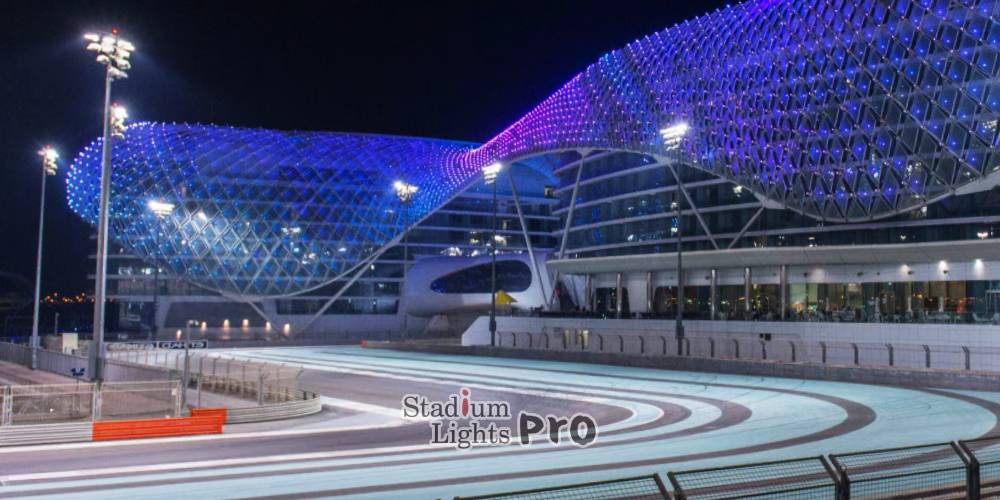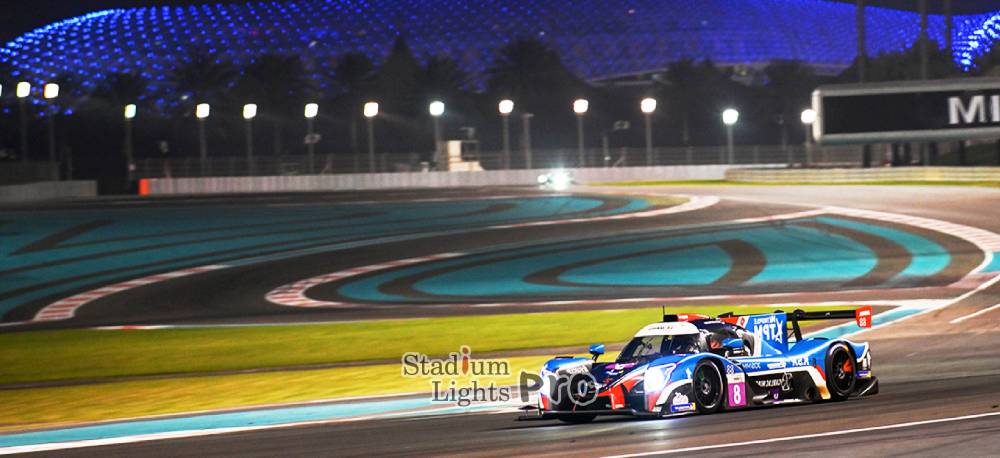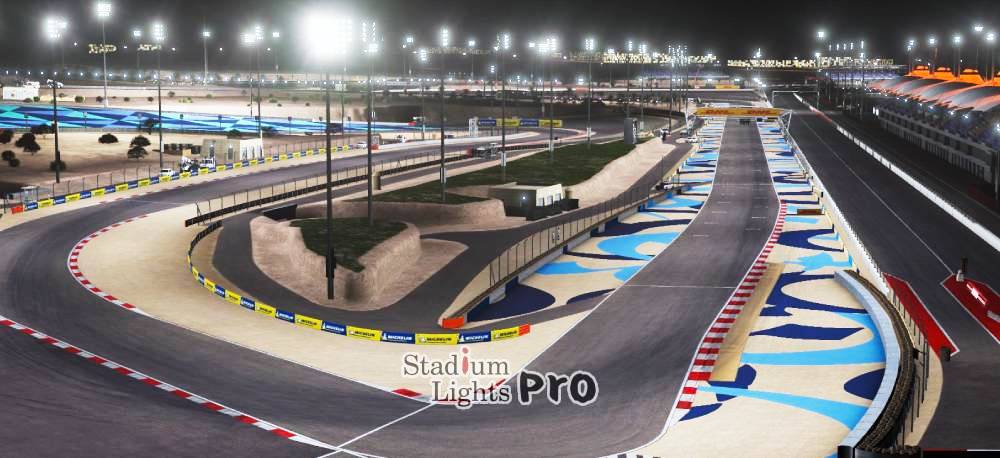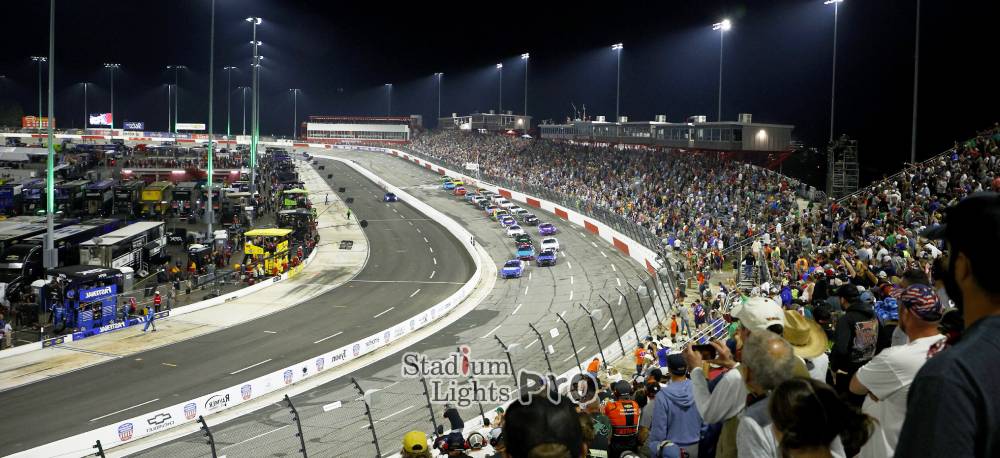Race tracks are complex venues where lighting serves multiple roles, from enhancing driver visibility to improving safety and supporting broadcast quality. The amount of illumination, measured in lux, varies widely depending on the type of racing, the track design, and the conditions under which events are held. Determining the appropriate lux level for race track lighting involves understanding factors such as speed, track size, driver needs, and audience expectations. Careful consideration ensures that lighting achieves clear visibility without causing glare or distracting drivers.
Table of Contents
ToggleUnderstanding Lux and Its Role in Race Track Lighting
Lux is a unit of illuminance that measures the amount of light falling on a surface per square meter. In the context of race tracks, lux serves as a fundamental metric for quantifying how brightly the racing surface and adjacent areas are illuminated. This measurement directly influences the ability of drivers, officials, and spectators to clearly perceive the environment, including the track layout, markings, and any potential hazards. A higher lux level corresponds to brighter lighting, which can enhance visibility and improve overall safety. However, it is not simply a matter of increasing brightness—excessive illumination can lead to glare, reduced contrast, and visual discomfort that may hamper driver performance and audience enjoyment. Therefore, achieving an appropriate balance in lux levels is a key consideration in race track lighting design.
Factors That Influence the Effectiveness of Lux

While lux provides a numerical value for brightness, its practical impact depends on several other factors that influence how light interacts with the race environment. One of these is lighting uniformity, which refers to the evenness of illumination across the track surface. Uneven lighting with sharp contrasts or dark spots can create visual confusion or fatigue for drivers who must react quickly at high speeds. Uniform lighting helps maintain consistent visibility, allowing drivers to anticipate corners and obstacles with greater confidence.
Another important aspect is the color temperature of the lighting, measured in Kelvins (K). Different color temperatures affect how natural or artificial the light appears. Cooler temperatures, often between 5,000 and 6,500K, mimic daylight and help enhance contrast and detail recognition. This clarity can be vital for drivers who need to discern subtle changes in the track surface or the movements of other competitors. Conversely, warmer light tones may make the environment appear softer but can reduce sharpness in visual perception.
Glare control also plays a significant role in how lux translates into usable illumination. Glare is caused by overly intense or misdirected light sources, which can temporarily blind or distract drivers. Careful fixture placement, shielding, and beam angle adjustments are employed to minimize glare while maintaining sufficient lux levels. The goal is to direct light precisely where it is needed, such as on braking zones and turns, without spilling into drivers’ eyes or off-track areas.
Special Challenges in Race Track Lighting
Race track lighting differs considerably from typical outdoor or sports venue lighting because of the exceptional speeds involved and the dynamic nature of racing. Vehicles can exceed 200 miles per hour, requiring lighting that allows drivers to process visual information with minimal delay. This means that not only must the track be bright enough, but the lighting must also be consistent and free from visual distractions.
Environmental factors add complexity as well. Weather conditions such as fog, rain, or dust can scatter light, reducing effective visibility. Lighting systems may incorporate adaptive controls that increase lux levels during adverse weather to compensate for diminished natural light transmission. Additionally, race tracks often operate during twilight or full nighttime hours, so lighting must bridge the transition between natural and artificial illumination smoothly to maintain driver orientation and safety.
Advancements in lighting technology, particularly LED systems, have made it possible to fine-tune lux levels with high precision and flexibility. LEDs provide superior control over beam direction, intensity, and color temperature, allowing lighting designers to customize illumination patterns tailored to each track’s unique layout and racing requirements. Such technologies also enhance energy efficiency and longevity compared to traditional lighting options, supporting sustainable operation for race venues.
Lux Recommendations for Different Types of Race Tracks
| Race Track Type | Typical Lux Range | Uniformity & Lighting Features | Color Temperature (K) | Fixture Details |
|---|---|---|---|---|
| Formula 1 Circuits | 800 – 1,200 lux | Uniformity ratio ≥ 0.8; high CRI (>85); zonal lighting control | 5,000 – 6,000 K (cool white) | 300+ LED fixtures; poles 15-30 meters high; supports UHD broadcast |
| Go-Kart Tracks | 200 – 500 lux | Even light distribution; minimizes shadows and glare | 4,000 – 5,000 K | 20-50 LED floodlights; poles or walls 8-12 meters high; energy efficient |
| Endurance Tracks (Le Mans) | 600 – 900 lux (up to 1,000 lux in critical zones) | Durable fixtures; dynamic dimming; glare control; steady illumination | Not specifically stated, generally daylight balanced | Hundreds of LEDs; poles 20-35 meters high; weather-resistant enclosures |
| Daytona International Speedway | 700 – 1,000 lux (daytime up to 1,200 lux) | High uniformity (>0.85); glare-controlled broad beams; tailored zones | Not specifically stated, optimized for broadcast and safety | Tall poles (25+ meters); combination of floodlights and spotlights |
| NASCAR Race Tracks | 600 – 900 lux | Wide, even coverage; glare control; minimizes shadows | 4,500 – 5,500 K | Perimeter poles 20-30 meters high; adjustable LED fixtures; broadcast friendly |
Formula 1 Circuits

Formula 1 circuits require some of the most advanced lighting systems found in motorsport. Given that many events take place during dusk or nighttime, the lighting must closely mimic natural daylight to help drivers accurately perceive track contours, braking zones, and apexes. Typical lux levels on the racing surface of Formula 1 tracks range from 800 to 1,200 lux, providing bright and consistent illumination across often expansive and complex layouts.
For context, 1,000 lux is roughly equivalent to the brightness of a well-lit office environment, yet the lighting for F1 circuits is engineered to deliver this intensity over large outdoor spaces with very high uniformity. Uniformity ratios of 0.8 or higher are common, which means the darkest areas receive at least 80% of the brightness of the brightest zones. This uniformity helps avoid shadows or glare that could distract drivers moving at speeds often exceeding 200 miles per hour.
The color rendering index (CRI) for these installations generally exceeds 85, with color temperatures between 5,000K and 6,000K, creating a cool white light that enhances contrast and detail clarity. Advanced LED lighting systems permit precise zonal control, allowing sections such as chicanes or hairpins to be brighter to aid visibility, while straights may be slightly dimmer but still well lit. Some circuits install over 300 high-performance LED fixtures on poles ranging from 15 to 30 meters in height to achieve these results. This lighting also supports ultra-high-definition broadcasts, enabling cameras to capture every detail with minimal color distortion.
Go-Kart Tracks
Go-kart tracks, being smaller and featuring lower speeds, require lighting that balances visibility with comfort. Typical lux levels range from 200 to 500 lux, sufficient for drivers to clearly see track boundaries, obstacles, and other karts without overwhelming the eyes or creating glare. This level is similar to the illumination found in retail stores or well-lit residential streets, offering clarity in compact racing environments.
Due to their smaller footprint, go-kart tracks often use between 20 and 50 LED floodlights mounted on poles or walls approximately 8 to 12 meters high. Uniform lighting is prioritized to avoid any pockets of darkness or intense brightness, which could distract or confuse drivers. Given the relatively low speeds, lighting systems focus on clear edge definition and minimizing shadows rather than extremely high lux levels.
Many tracks employ lighting with color temperatures near 4,000K to 5,000K, balancing warmth and brightness for a natural yet energizing atmosphere. These installations also emphasize energy efficiency, with LED fixtures reducing operational costs while maintaining steady performance.
Endurance Tracks – Le Mans

Endurance racing, exemplified by the 24 Hours of Le Mans, poses unique challenges for lighting due to the extended duration and shifting conditions from daylight to full night. Lighting at such venues must ensure visibility throughout the night, often for over 10 hours, while managing energy consumption and reducing visual fatigue for drivers who endure prolonged exposure.
Lux levels on Le Mans-style tracks typically range from 600 to 900 lux on high-priority areas such as pit lanes, critical corners, and braking zones. This intensity corresponds roughly to the brightness of a well-lit parking lot or sports arena, but with stricter uniformity and glare control requirements. Some sections of the track may receive up to 1,000 lux to aid visibility in areas with higher risk or complexity.
Illumination systems at endurance circuits often comprise hundreds of LED fixtures mounted on poles between 20 and 35 meters high. These are designed for long-term reliability with robust enclosures to withstand weather and vibration. Many systems incorporate dynamic lighting controls that simulate natural light changes during dawn and dusk transitions, helping to ease driver adaptation and reduce fatigue. Additionally, some lighting setups include sensors to adjust brightness based on ambient conditions like fog or rain.
Daytona International Speedway
The Daytona International Speedway is renowned for hosting NASCAR and endurance events, necessitating a lighting system that combines high intensity with excellent coverage. Lux levels on the main racing surface generally range between 700 and 1,000 lux, providing clear visibility across the track’s wide straights and steep banking.
Daytona’s lighting design features numerous tall poles, often exceeding 25 meters, fitted with cutting-edge LED fixtures capable of producing broad, glare-controlled beams. This ensures drivers can spot subtle details such as track markings, tire debris, or small hazards without being blinded by excessive brightness. The lighting towers are spaced to maintain high uniformity ratios, often above 0.85, minimizing shadows and dark spots even on banked turns.
For spectators, additional lighting is installed to enhance the viewing experience in grandstands and pit areas without spilling excessively onto the track. The system uses a combination of floodlights and spotlights with adjustable angles, allowing the lighting scheme to be tailored for different event types. Daytime lux levels at Daytona can reach 1,200 lux during daytime qualifying sessions, while night races maintain steady illumination around 800 to 1,000 lux for safety and broadcast quality.
NASCAR Race Tracks

NASCAR race tracks require lighting systems that can accommodate high-speed oval racing with frequent pack racing and close-quarters competition. The typical lux levels for NASCAR tracks range from 600 to 900 lux on the racing surface, providing ample brightness for drivers to maintain sharp awareness of their surroundings at speeds often surpassing 180 miles per hour.
Oval tracks used in NASCAR, such as Talladega or Bristol Motor Speedway, feature long straights combined with varying banking angles, creating unique challenges for lighting uniformity and glare control. Lighting towers are generally positioned around the perimeter, with fixtures mounted between 20 and 30 meters high to deliver wide, even coverage. The design aims to eliminate shadows that could obscure debris or track irregularities, while preventing glare that might distract drivers in close proximity.
The color temperature used in NASCAR lighting systems typically falls between 4,500K and 5,500K, balancing natural daylight simulation with reduced eye strain during prolonged night races. Modern LED fixtures provide the flexibility to adjust light intensity dynamically, ensuring consistent visibility even under changing weather or ambient light conditions. These systems also support high-definition broadcasting needs by maintaining color accuracy and minimizing flicker, which enhances the viewing experience for fans worldwide.
Factors Influencing Required Lux Levels
Speed and Visibility Needs
The velocity of racing vehicles plays a large role in determining how much illumination is required on a track. As speeds increase, drivers must rapidly interpret visual cues such as track edges, braking zones, and obstacles. Higher lux levels help by making these details more discernible, effectively shortening reaction times and extending the distance a driver can clearly see ahead. At extreme speeds, any inconsistency in lighting, such as shadows or patches of lower brightness, can lead to hazardous blind spots that disrupt a driver’s perception. Therefore, tracks hosting fast-paced events tend to demand both greater lighting intensity and uniformity to maintain a stable and comfortable visual environment.
Track Size and Shape
The physical dimensions and geometric complexity of a race track heavily influence lighting requirements. Larger circuits with multiple curves, elevation changes, and varying widths present challenges in achieving even illumination across all areas. Lighting systems must be carefully designed to address these complexities, often involving adjustable fixture angles and strategic placement of poles to avoid dark zones or glare spots. Maintaining consistent lux levels throughout the track minimizes sudden brightness fluctuations that could momentarily impair driver focus or cause discomfort. This also ensures that every segment of the track, from straightaways to hairpin turns, receives optimal visibility.
Weather and Ambient Light Conditions
Environmental factors surrounding race tracks can have a notable impact on lighting needs. Conditions such as fog, rain, dust, or mist can scatter and absorb light, reducing visibility and requiring higher lux levels to compensate. Many modern lighting installations incorporate adaptive controls or sensors that adjust brightness according to weather or atmospheric conditions to maintain safety and clarity. Furthermore, ambient light from nearby urban areas, streetlights, or the gradual transition from daylight to night alters how bright the track’s artificial lighting must be. Lighting schemes often factor in these external influences to ensure consistent performance regardless of time or weather.
Broadcasting and Spectator Experience
Today’s motorsport events are frequently broadcast live in high-definition formats, making lighting design more complex than simply illuminating the track for drivers. Lighting must support television cameras by minimizing flicker, providing accurate color rendering, and balancing brightness to avoid overexposure or washed-out images. The lux levels and color temperature are selected to enhance visual clarity for viewers while preserving the natural appearance of the race environment. At the same time, on-site spectators benefit from well-lit stands, pit areas, and viewing zones that complement track lighting without causing glare or spill light. Integrating these requirements into the lighting plan helps create an immersive and enjoyable experience for all audiences.
Lighting Uniformity and Glare Control
While lux measures the overall brightness on a surface, lighting uniformity focuses on how evenly that light is distributed across the entire race track. Maintaining a consistent illumination level helps prevent sudden shifts in brightness that can momentarily impair a driver’s vision or cause disorientation, particularly when traveling at high speeds. Typically, optimal uniformity ratios for race tracks fall between 0.7 and 0.9, meaning the dimmest areas retain at least 70% to 90% of the brightness of the brightest spots. This consistency supports safer driving conditions and improves visual comfort by reducing harsh contrasts and shadows.
Glare control plays a complementary role in enhancing visibility by minimizing excessive brightness that can cause discomfort or temporary blindness. High-speed environments make glare especially problematic, as drivers rely heavily on clear, uninterrupted sight lines to navigate safely. To mitigate glare, lighting systems utilize fixture shielding, carefully aimed directional lighting, and advanced diffusion techniques that spread light more evenly. Modern LED technology often incorporates specialized lenses, baffles, and reflectors designed to contain stray light and focus illumination precisely where it is needed on the racing surface. These measures ensure that lux levels remain effective without overwhelming the drivers’ vision or creating distracting glare, supporting both safety and performance during night races or low-light conditions.
Closing Thoughts on Race Track Lux Requirements
Lighting a race track involves more than simply achieving a numeric lux target. It requires a holistic approach that balances brightness, uniformity, glare control, color temperature, and energy efficiency. Different types of racing, from high-speed Formula 1 events to smaller go-kart circuits, have varying lux needs that align with their unique characteristics.
Lux levels for race tracks usually fall between 200 lux for smaller venues up to 1,200 lux for top-tier circuits. Proper lighting supports driver safety, enhances spectator experience, and enables high-quality broadcast coverage. Advances in LED technology and lighting design continue to improve how tracks manage illumination challenges, ensuring that race events run smoothly and visually impressively at all hours.
Choosing the right lux level involves understanding the specific demands of each racing format and environment, factoring in speed, track size, and ambient conditions. With well-designed lighting systems, race tracks can provide clear visibility, minimize visual fatigue, and create an exciting atmosphere for drivers and fans alike.

